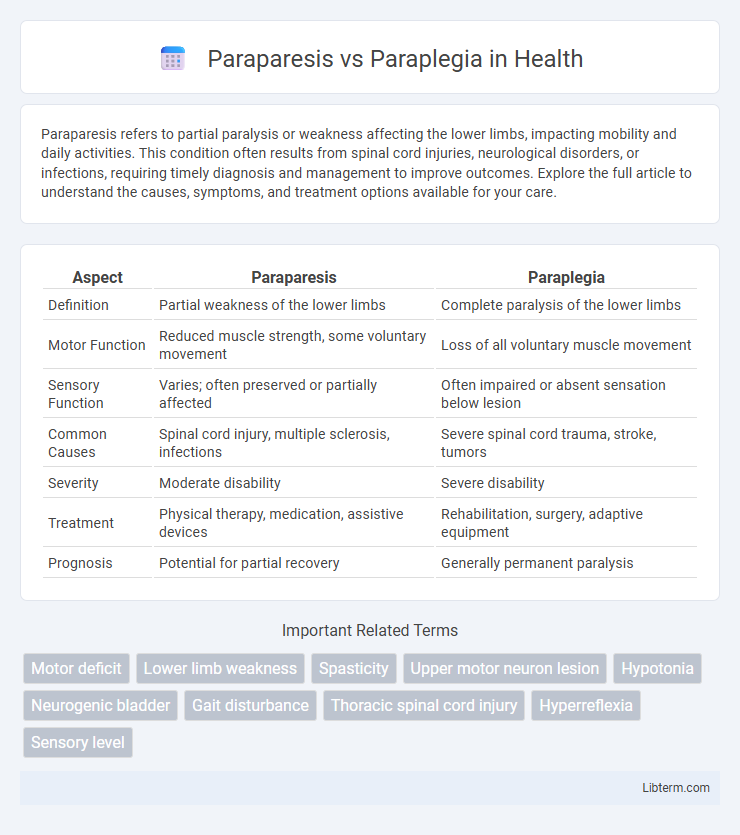Paraparesis refers to partial paralysis or weakness affecting the lower limbs, impacting mobility and daily activities. This condition often results from spinal cord injuries, neurological disorders, or infections, requiring timely diagnosis and management to improve outcomes. Explore the full article to understand the causes, symptoms, and treatment options available for your care.
Table of Comparison
| Aspect | Paraparesis | Paraplegia |
|---|---|---|
| Definition | Partial weakness of the lower limbs | Complete paralysis of the lower limbs |
| Motor Function | Reduced muscle strength, some voluntary movement | Loss of all voluntary muscle movement |
| Sensory Function | Varies; often preserved or partially affected | Often impaired or absent sensation below lesion |
| Common Causes | Spinal cord injury, multiple sclerosis, infections | Severe spinal cord trauma, stroke, tumors |
| Severity | Moderate disability | Severe disability |
| Treatment | Physical therapy, medication, assistive devices | Rehabilitation, surgery, adaptive equipment |
| Prognosis | Potential for partial recovery | Generally permanent paralysis |
Understanding Paraparesis: Definition and Overview
Paraparesis refers to the partial weakness or incomplete paralysis affecting the lower limbs, often resulting from spinal cord injuries, multiple sclerosis, or inflammatory diseases. Unlike paraplegia, which indicates complete paralysis of the lower extremities, paraparesis allows for some voluntary movement and muscle control. Understanding paraparesis involves recognizing its diverse neurological causes and the varying degrees of motor function impairment.
What is Paraplegia? Key Characteristics
Paraplegia is a neurological condition characterized by the complete or partial paralysis of the lower limbs and lower body, typically resulting from spinal cord injury or disease affecting the thoracic, lumbar, or sacral segments. Key characteristics include loss of motor function and sensation below the site of injury, impaired bladder and bowel control, and muscle spasticity or flaccidity depending on the lesion level. Unlike paraparesis, which involves partial weakness, paraplegia manifests as full paralysis, significantly impacting mobility and daily activities.
Main Causes of Paraparesis
Paraparesis is characterized by partial paralysis affecting the lower limbs, while paraplegia involves complete paralysis. The main causes of paraparesis include spinal cord injuries, multiple sclerosis, transverse myelitis, and hereditary spastic paraplegia. Early diagnosis and targeted treatment are crucial to managing symptoms and preventing progression to paraplegia.
Common Causes of Paraplegia
Paraplegia, characterized by complete paralysis of the lower limbs, is commonly caused by spinal cord injuries due to trauma such as car accidents, falls, or sports injuries. Other frequent causes include neurological diseases like multiple sclerosis, transverse myelitis, and spinal cord tumors, which disrupt nerve signal transmission. Unlike paraparesis, which involves partial weakness, paraplegia results in a total loss of motor function below the lesion site.
Symptoms: Paraparesis vs Paraplegia
Paraparesis is characterized by partial weakness or reduced motor function in the lower limbs, often allowing some degree of movement and sensation, whereas paraplegia involves complete paralysis and loss of sensation below the waist. Symptoms of paraparesis include muscle stiffness, spasticity, and difficulty walking, while paraplegia results in total loss of voluntary muscle control and sensation, often accompanied by bladder and bowel dysfunction. Differentiating between these conditions is crucial for prognosis and rehabilitation planning, with MRI and neurological exams aiding in diagnosis.
Diagnostic Criteria for Both Conditions
Paraparesis presents as partial weakness affecting the lower extremities, often diagnosed through clinical examination revealing muscle strength graded between 1 and 4 on the Medical Research Council scale, alongside electromyography and nerve conduction studies to assess neuromuscular involvement. Paraplegia is characterized by complete paralysis of the lower limbs, confirmed by comprehensive neurological assessment demonstrating absent voluntary movement and sensation below the lesion level, supported by MRI imaging to identify spinal cord damage. Both conditions require differentiating central versus peripheral nervous system pathology through diagnostic tools including somatosensory evoked potentials and spinal cord evoked potentials.
Differences in Muscle Strength and Mobility
Paraparesis involves partial weakness or reduced muscle strength in the lower limbs, allowing some degree of movement and mobility, whereas paraplegia results in complete paralysis of the lower limbs, causing total loss of voluntary muscle control. Muscle strength in paraparesis is typically diminished but present, enabling limited walking or assisted movement, while paraplegia leads to an inability to bear weight or initiate any lower limb movement. Mobility in individuals with paraparesis may range from impaired to functional with support, contrasting with paraplegia, where mobility usually requires wheelchairs or other assistive devices.
Treatment Options Comparison
Treatment options for paraparesis primarily involve physical therapy, medications such as corticosteroids to reduce inflammation, and assistive devices to improve mobility, aiming to restore partial muscle strength. In contrast, paraplegia management often requires more intensive rehabilitation, including wheelchair training, spasticity control with antispasmodic drugs, and surgical interventions like spinal cord stimulation or nerve transfer to maximize functionality. Both conditions benefit from multidisciplinary care, but paraplegia typically demands long-term adaptive strategies due to complete lower limb paralysis.
Prognosis and Long-Term Outcomes
Paraplegia typically results in complete paralysis below the level of spinal cord injury, leading to permanent loss of motor and sensory function, whereas paraparesis involves partial weakness with varying degrees of motor recovery possible. Prognosis for paraparesis is generally more favorable, with many patients regaining significant functionality through rehabilitation and neuroplasticity, while paraplegia often requires long-term assistive devices and management of secondary complications like pressure ulcers and autonomic dysreflexia. Long-term outcomes for paraparesis include improved mobility and independence, whereas paraplegia's outcomes focus on maximizing quality of life despite persistent motor deficits and potential comorbidities.
Coping Strategies and Support Resources
Paraparesis and paraplegia require tailored coping strategies, emphasizing physical rehabilitation, adaptive equipment, and psychological support to manage mobility challenges effectively. Engaging with specialized support groups, such as the Christopher & Dana Reeve Foundation and local spinal cord injury associations, enhances emotional well-being and provides access to rehabilitation services. Utilizing resources like physical therapists, occupational therapists, and mental health counselors ensures comprehensive care that addresses both physical limitations and emotional resilience.
Paraparesis Infographic

 libterm.com
libterm.com